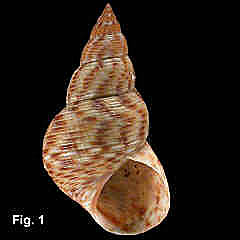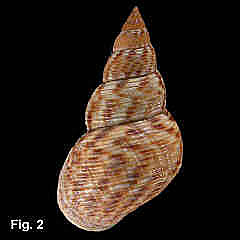|
|
|
|
|
Littoraria luteola (Quoy & Gaimard, 1833) Description: Shell lightweight, whorls rounded, occasionally with up to 4 varices. Fourth whorl of teleoconch with 8-10 thin, fine spiral grooves. Body whorl with 18-23 spiral ribs, usually evenly spaced with grooves narrower than ribs, but occasionally of irregular size and spacing; 2 ribs on periphery strongest, usually markedly so. Columella smooth, narrow, not excavated, purple in colour (but fading to creamy orange in dead shells). Outer lip thin. Colour very variable; usually dark brown, less frequently reddish brown or yellow, with or without pattern of dashes or stripes. Operculum corneous. Size: Adults usually within the range 8-23 mm in height; maximum known 28 mm. Distribution: Restricted to eastern Australia; Torres Strait islands southwards to Merimbula, NSW. Habitat: "Leaves and trunks of the mangrove Avicennia; in forests consisting entirely of Avicennia in southern NSW it occurs from the seaward edge to back of forests, 0.4-2.2 m. above ground; in more complex forests in Queensland it occurs in the Avicennia fringe and Ceriops zone; also found at back of swamps in saltmarsh vegetation and on and under driftwood at ground level" (Reid, 1986). Comparison: Of the three species of Littoraria found in NSW, L. luteola is by far the most common, and is the only species found south of Botany Bay. L. luteola is a small shell with a thin, rounded columella. L. filosa is larger and differs by having much stronger sculpture - only 9-11 strong, widely spaced ribs on the body whorl - but with a similar columella. L. philippiana is also larger, and easily distinguished by its wide, excavated, purple columella. Synonymy: Formerly frequently misidentified as Littorina scabra (Linnaeus, 1758), but see remarks below. Remarks: The common littorinids that live on mangrove leaves and trunks throughout the Indo-West Pacific have long been regarded as one variable species, Littorina scabra (Linnaeus, 1758). However, in 1986, Dr. David Reid published the results of comprehensive investigation into the "species" and concluded there were actually twenty separate species involved! Each species is quite constant in shell sculpture and in the habitat in occupies in mangrove forests, and most are restricted in range to a part of the Indo-West Pacific region. As well as looking at shell characters, Reid was able to characterise each species by its anatomy, particularly penis shape, reproductive tract structure and structure of sperm cells. The data presented here on distribution and habit follow this work (Reid, 1986). Figs. 1,2: Gunnamatta Bay, NSW (C.319258) Fig. 3: All from Quibray Bay, near Kurnell, NSW (C.319257) |


